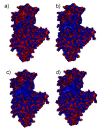Albumin-Hyaluronan Interactions: Influence of Ionic Composition Probed by Molecular Dynamics
- PMID: 34830249
- PMCID: PMC8625520
- DOI: 10.3390/ijms222212360
Albumin-Hyaluronan Interactions: Influence of Ionic Composition Probed by Molecular Dynamics
Abstract
The lubrication mechanism in synovial fluid and joints is not yet fully understood. Nevertheless, intermolecular interactions between various neutral and ionic species including large macromolecular systems and simple inorganic ions are the key to understanding the excellent lubrication performance. An important tool for characterizing the intermolecular forces and their structural consequences is molecular dynamics. Albumin is one of the major components in synovial fluid. Its electrostatic properties, including the ability to form molecular complexes, are closely related to pH, solvation, and the presence of ions. In the context of synovial fluid, it is relevant to describe the possible interactions between albumin and hyaluronate, taking into account solution composition effects. In this study, the influence of Na+, Mg2+, and Ca2+ ions on human serum albumin-hyaluronan interactions were examined using molecular dynamics tools. It was established that the presence of divalent cations, and especially Ca2+, contributes mostly to the increase of the affinity between hyaluronan and albumin, which is associated with charge compensation in negatively charged hyaluronan and albumin. Furthermore, the most probable binding sites were structurally and energetically characterized. The indicated moieties exhibit a locally positive charge which enables hyaluronate binding (direct and water mediated).
Keywords: human serum albumin; hyaluronan; hyaluronic acid; hydrogen bonds; ionic interactions; molecular dynamics simulations; water mediated interactions.
Conflict of interest statement
The authors declare no conflict of interest.
Figures













Similar articles
-
Effect of Ion and Binding Site on the Conformation of Chosen Glycosaminoglycans at the Albumin Surface.Entropy (Basel). 2022 Jun 10;24(6):811. doi: 10.3390/e24060811. Entropy (Basel). 2022. PMID: 35741532 Free PMC article.
-
Atomic-Resolution Experimental Structural Biology and Molecular Dynamics Simulations of Hyaluronan and Its Complexes.Molecules. 2022 Oct 26;27(21):7276. doi: 10.3390/molecules27217276. Molecules. 2022. PMID: 36364098 Free PMC article. Review.
-
Influence of the Molecular Weight and the Presence of Calcium Ions on the Molecular Interaction of Hyaluronan and DPPC.Molecules. 2020 Aug 27;25(17):3907. doi: 10.3390/molecules25173907. Molecules. 2020. PMID: 32867196 Free PMC article.
-
Unravelling the binding mechanism and protein stability of human serum albumin while interacting with nefopam analogues: a biophysical and insilico approach.J Biomol Struct Dyn. 2017 Aug;35(10):2280-2292. doi: 10.1080/07391102.2016.1216895. Epub 2016 Aug 16. J Biomol Struct Dyn. 2017. PMID: 27453381
-
Hyaluronan: polysaccharide chaos to protein organisation.Curr Opin Struct Biol. 2001 Oct;11(5):617-22. doi: 10.1016/s0959-440x(00)00256-6. Curr Opin Struct Biol. 2001. PMID: 11785764 Review.
Cited by
-
Effect of Ion and Binding Site on the Conformation of Chosen Glycosaminoglycans at the Albumin Surface.Entropy (Basel). 2022 Jun 10;24(6):811. doi: 10.3390/e24060811. Entropy (Basel). 2022. PMID: 35741532 Free PMC article.
-
Effect of Chitosan Deacetylation on Its Affinity to Type III Collagen: A Molecular Dynamics Study.Materials (Basel). 2022 Jan 8;15(2):463. doi: 10.3390/ma15020463. Materials (Basel). 2022. PMID: 35057179 Free PMC article.
-
Atomic-Resolution Experimental Structural Biology and Molecular Dynamics Simulations of Hyaluronan and Its Complexes.Molecules. 2022 Oct 26;27(21):7276. doi: 10.3390/molecules27217276. Molecules. 2022. PMID: 36364098 Free PMC article. Review.
-
New Materials Based on Molecular Interaction between Hyaluronic Acid and Bovine Albumin.Molecules. 2022 Aug 4;27(15):4956. doi: 10.3390/molecules27154956. Molecules. 2022. PMID: 35956906 Free PMC article.
-
Characterization of Synovial Fluid Components: Albumin-Chondroitin Sulfate Interactions Seen through Molecular Dynamics.Materials (Basel). 2022 Oct 6;15(19):6935. doi: 10.3390/ma15196935. Materials (Basel). 2022. PMID: 36234275 Free PMC article.
References
MeSH terms
Substances
LinkOut - more resources
Full Text Sources
Miscellaneous

